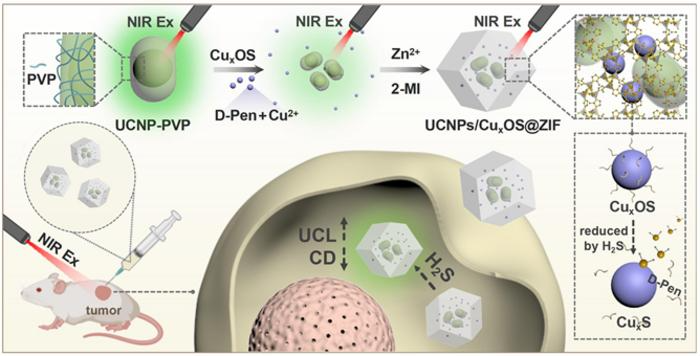Reviewed by Lexie CornerAug 6 2024
A team of scientists led by Professor Geyu Lu from Jilin University, China, developed a UCNPs/CuxOS@ZIF nanocomposite probe for dual-mode H2S sensing and in vivo imaging. Their study was recently published in Light: Science & Application.
 The designed UCNPs are encapsulated in ZIF-8 along with CuxOS nanoparticles. Due to the quenching of UCL by CuxOS, the UCL signal of the UCNPs/CuxOS@ZIF nanocomposite probe under 980 nm excitation is weak. At this time, the probe showed a significant CD signal due to CuxOS. When H2S exists in the detection environment, the destruction of CuxOS by H2S weakens the CD signal of the probe, while the UCL signal of UCNPs is restored. Based on this principle, UCL/CD dual-mode sensing against H2S is realized in vitro. At the same time, as one of the typical biomarkers of cancer, the high expression of H2S in the tumor also enhances the UCL signal of the probe inside the tumor, achieving bioimaging in vivo. Image Credit: Yang Lu, Xu Zhao, Dongmei Yan, Yingqian Mi, Peng Sun, Xu Yan, Geyu Lu, and Xiaomin Liu.
The designed UCNPs are encapsulated in ZIF-8 along with CuxOS nanoparticles. Due to the quenching of UCL by CuxOS, the UCL signal of the UCNPs/CuxOS@ZIF nanocomposite probe under 980 nm excitation is weak. At this time, the probe showed a significant CD signal due to CuxOS. When H2S exists in the detection environment, the destruction of CuxOS by H2S weakens the CD signal of the probe, while the UCL signal of UCNPs is restored. Based on this principle, UCL/CD dual-mode sensing against H2S is realized in vitro. At the same time, as one of the typical biomarkers of cancer, the high expression of H2S in the tumor also enhances the UCL signal of the probe inside the tumor, achieving bioimaging in vivo. Image Credit: Yang Lu, Xu Zhao, Dongmei Yan, Yingqian Mi, Peng Sun, Xu Yan, Geyu Lu, and Xiaomin Liu.
Advancements in nanotechnology have led to the creation of numerous artificial chiral nanoparticles. Circular dichroism (CD) is a powerful sensing technique and a key optical feature of these chiral nanoparticles, offering greater sensitivity than other analytical methods. However, CD cannot be used for in vivo in-situ imaging. To overcome this, scientists have developed chiral nanocomposites with enhanced biological functions.
Challenges arise when chiral nanocomposites, formed through electrostatic adsorption or other methods, degrade in complex physiological environments. Additionally, many nanocomposites have low detection selectivity due to interference from similar analytes. Thus, creating stable and superior chiral composite nanomaterials for biological diagnostics remains a challenge.
In this study, Zeolitic lmidazolate framework-8 (ZIF-8) encapsulates chiral CuxOS nanoparticles and upconversion nanoparticles (UCNPs) in the probe. H2S reduces CuxOS, altering the probe’s absorption and CD signal, enabling dual-mode UCL/CD sensing in vitro and live tumor imaging in situ.
The development of UCNPs/CuxOS@ZIF nanoprobes represents a novel approach in biomedicine, improving the selectivity and functionality of chiral nanomaterials for biological detection. The scientists detailed the probe’s highly selective H2S sensing mechanism.
Scientists noted, “The realization of this ‘selection’ actually comes from ZIF-8, which we designed as an encapsulation shell for the entire nanocomposite, not only to stabilize the composite but, more importantly, to use its unique pore structure to enable it to function as a gas molecular sieve. In short, H2S molecules easily enter the inside of ZIF-8, while other molecules are isolated from the outside, thus resolving some common molecular influences on probe sensing to a certain extent.”
They added, “Without the encapsulation of ZIF-8, reductive substances such as L-Cys, L-Lys, and GSH can also alter the UCL and CD signals of the probe, and this effect is extremely unfavorable for the evaluation of the sensing performance of the probe.”
“The assembly idea used in this nanocomposite probe can be applied to the assembly of other kinds of composite. As long as the design is reasonable, more diversified multi-functional chiral composites can be prepared, creating more possibilities for the application of chirality in the field of biosensing, bioimaging, and biotherapy,” they concluded.
Journal Reference:
Lu, Y., et al. (2024) Upconversion-based chiral nanoprobe for highly selective dual-mode sensing and bioimaging of hydrogen sulfide in vitro and in vivo. Light: Science & Applications. doi:10.1038/s41377-024-01539-6